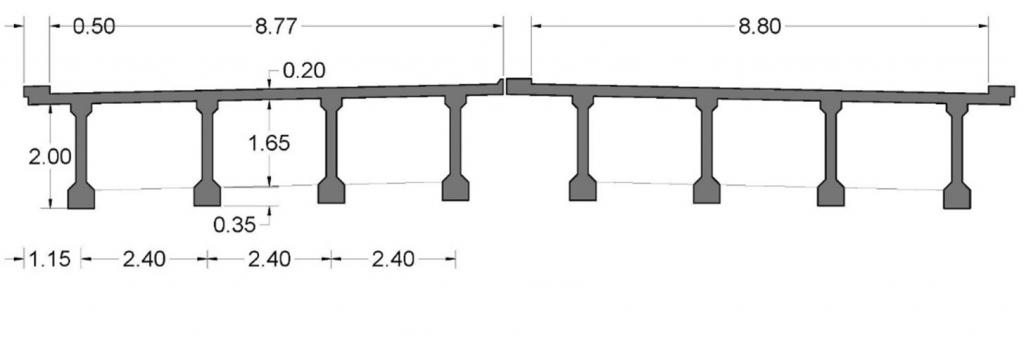The Alveo Vecchio viaduct, built in 1968, is composed of two independent structures, one per carriageway, each consisting of three bays in c.a.p. having the static scheme of beams simply supported. Both decks have four ribs in c.a.p. of 2.40 m distance and 2.0 m height, surmounted by a slab 20 cm thick, an integral part of the resistant section of the beam. The ribs are connected by three intermediate traverses and two head traverses, 25 cm thick. The theoretical light of the ribs, meaning the distance between the supports is 32.50 m.

Image: Map; Longitudinal selection

Image: Plant; Cross selection
The prestressing system consists of 14 post-tensioned cables for each beam. Each cable, having a parabolic path, consists of 12 7 mm wires, arranged in parallel within a metal injected sheath. The rated breaking voltage of the wires is 1,700 MPa, the rated yield strength is 1,450 MPa, and the initial tensile strength is 1,250 MPa. The batteries are septum, having a reduced height (about 3.30 m including pulvinus), with a foundation sole of size 18.50 x 6.00 m and thickness 1.60 m, on eight drilled poles of diameter 1.20 m and length 23 m. The shoulders are instead based on six poles of the same diameter 1,20 m. The work has a straight line and the level has a slope of 1.45% from Bari towards Naples.

Image: Trend of Cables
As regards the materials used, the calculation report used a concrete compressive strength of 400 kg/cm2 and an allowable stress of 2,200 kg/cm2 for slow reinforcements. Other characteristics of the materials are not known a priori. The structure has been dimensioned according to the legislation in force at the time, the Circ. Min. LL.PP. 14/02/1962, No. 384. The test was carried out in 1969.
In 2015, a landslide affected the bridge and resulted in its decommissioning following the collapse of the C1dx span and the roto-translation of batteries 1 both right and left. From an inspection carried out on 9 May 2019, it was observed that bay 3 remained intact and was not affected by the landslide, thus being potentially suitable for a load test. On the other hand, no conclusions could be drawn as to the state of the foundations of the vertical elements, in particular stack 2 on which bay 3 rests. The structure did not show any fissures, iron cover detachments, and signs of corrosion of the reinforcements. With a preliminary load test on stack 2 and on the shoulder side of Bari, carried out between 1 and 4 July 2019, the integrity of the foundation poles was verified, with subsidence of less than 0.1 mm for a load of 480 t first on the pile, and then on the shoulder.
